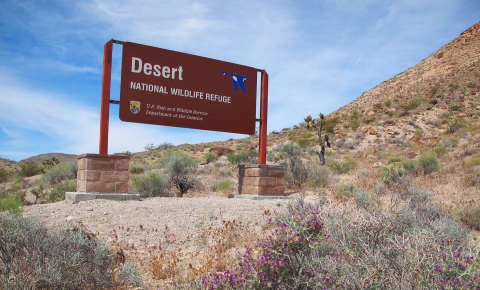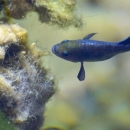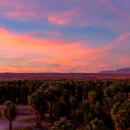About Us
Encompassing six major mountain ranges and seven distinct life zones, Desert NWR showcases the abundance and variety of nature that can be found in Southern Nevada, all just a short drive from Las Vegas.
Created in 1936 to provide habitat and protection for desert bighorn sheep and other desert wildlife, Desert NWR is the largest wildlife refuge outside of Alaska. At 1.6 million acres (643,000 hectares), the refuge can cover Rhode Island twice - and still have enough room left over for a quarter of a million football fields. Teeming with diversity over a vast landscape, Desert NWR boasts over 500 plant species as it transitions from the Mojave to the Great Basin Desert.
While Desert NWR has been home to people for thousands of years, from Newe (Western Shoshone) and Nuwu/Nuwuvi (Southern Paiute/Chemehuevi) to ranch homesteaders, the refuge still remains largely unchanged by human hands. Over 1.3 million acres (536,000 hectares) of the refuge is proposed wilderness and has been managed as de facto wilderness since 1974. See collared lizards sunning on rocks, hunt for tracks of elusive mountain lions, or grab your binoculars for a better look at our 320 bird species. A unique and solitary experience awaits you at Desert NWR.
Our Mission
The mission of the National Wildlife Refuge System is to administer a national network of lands and waters for the conservation, management and, where appropriate, restoration of the fish, wildlife and plant resources and their habitats within the United States for the benefit of present and future generations of Americans.
Our History
May 20, 1936 – President Franklin D. Roosevelt established the Desert Game Range for “the conservation and development of natural wildlife resources” (Executive Order 7373). The 2.25 million acre Game Range, under the joint administration of the U.S. Fish and Wildlife Service and the Bureau of Land Management, included most of the lands within the current Refuge boundary, but also stretched south to include portions of the Spring Mountains and the area currently occupied by Red Rock Canyon National Conservation Area.
1939 – A 320-acre ranch at Corn Creek (now the site of the visitor center) was acquired from a private landowner under the authority of the Migratory Bird Conservation Act. This site became the administrative headquarters for the Game Range.
October, 1940 – Approximately 846,000 acres of the Desert Game Range were reserved for the use of the War Department (U.S. Department of Defense [DOD]) as an aerial bombing and gunnery range (now known as the NTTR). The USAF’s use of a portion of the Desert Game Range was governed by a Memorandum of Understanding (MOU) signed in 1949.
August 31, 1966 – Public Land Order 4079, established the Desert National Wildlife Range under the sole administration of the Bureau of Sport Fisheries and Wildlife (now the U.S. Fish & Wildlife Service). It also reduced the size of the refuge to 1,588,000 acres.
1971 – 88% or 1,443,100 acres was identified and recommended as wilderness by the U.S. Fish and Wildlife Service under the Wilderness Act of 1964 due to the area’s extensive primitive and roadless qualities. Seven individual wilderness units were identified in this process.
1970-1985 – 440 acres in the vicinity of Corn Creek was purchased from a variety of private land owners under the authority of the Endangered Species Act (16 USC Sec. 1534) and Refuge Recreation Act (16 USC Sec. 460k-460).
November 6th, 2002 – President George W. Bush signed the Clark County Conservation of Public Land and Natural Resources Act of 2002 (PL 107–282), which administratively transferred 26,433 acres of BLM land adjacent to Desert NWR’s east boundary to the Service. Desert NWR’s land base changed again with the passage of the Lincoln County Conservation, Recreation, and Development Act of 2004 (PL 108–424). As part of the Act, administrative jurisdiction over approximately 8,382 acres of land along the eastern boundary of Desert NWR and west of U.S. Highway 93 was transferred from the Service to the BLM for use as a utility corridor. In addition, 8,503 acres of BLM-administered land was transferred to the Service to be managed as part of the Desert NWR. This land is located at the northeastern boundary of the Desert NWR and the western boundary of Pahranagat NWR.
June, 2003 – The Pahrump Poolfish, a threatened fish whose original habitat was destroyed by groundwater pumping, was introduced to the newly constructed refugium tank.
2010 – Former irrigation ponds at Corn Creek were removed and a new concrete pond was constructed. Most of the former trail system at Corn Creek was replaced during this construction period as well.
December, 2013 – Construction of the current visitor center completed and staff moved into their offices. A formal grand opening to the public was held in February, 2014.
Other Facilities in this Complex
Desert National Wildlife Refuge (NWR) is managed as part of the Desert National Wildlife Refuge Complex. A National Wildlife Refuge Complex is an administrative grouping of two or more refuges, wildlife management areas or other refuge conservation areas that are primarily managed from a central office location. Refuges are grouped into a complex structure structure
Something temporarily or permanently constructed, built, or placed; and constructed of natural or manufactured parts including, but not limited to, a building, shed, cabin, porch, bridge, walkway, stair steps, sign, landing, platform, dock, rack, fence, telecommunication device, antennae, fish cleaning table, satellite dish/mount, or well head.
Learn more about structure because they occur in a similar ecological region, such as a watershed or specific habitat type, and have a related purpose and management needs. Typically, a project leader or complex manager oversees the general management of all refuges within the complex and refuge managers are responsible for operations at specific refuges. Supporting staff, composed of administrative, law enforcement, refuge manager, biological, fire, visitor services, and maintenance professionals, are centrally located and support all refuges within the complex.
Other refuges in the Desert National Wildlife Refuge Complex include: Ash Meadows NWR, Moapa Valley NWR, and Pahranagat NWR. The Refuge Complex headquarters is located at 4701 North Torrey Pines Drive, Las Vegas, Nevada 89130.








